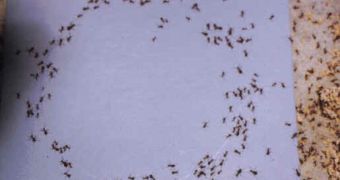The precision that ants employ when moving to and from their hives has puzzled scientists for a very long time, in that several hundred thousand individuals exhibited the ability to follow simple and effective commands, so as not to create traffic congestions and slow down the hunters that are looking for their prey. Understanding their motion flow could help urban planners and architects develop better highways, where cars never stop to form blocks.
The basic mechanism ants employ refers to "nudging," which happens when a loaded ant returns to the nest with its prey. The ant coming from the nest is thrown off-course, in order to make way for the incoming ant, which cannot move with much agility under its burden. This behavior minimizes the time food takes to reach the hive and the queen, which is the main goal of all working ants.
When setting up trails to hunt, ants that scout ahead lay down a scent, which helps their nearly-blind companions follow. Along this scent trail, three lanes are formed. The inner one is circulated by workers returning to the hive, loaded with invertebrates, while the two outside lanes are composed of the individuals going towards the hunting grounds, which move much more quickly. This setup helps the carriers return faster, so the scent is strongest on the middle path.
Biologists say that this type of behavior came as an adaptation to thousands, if not millions of years of evolution, when nomad ants became, well, nomads, as their hunting ranges were extensive and the food became scarce. But the bottom line is that they do not regulate their traffic with Ministers and other officials, but by commonly following a set of rules, so as to maximize their efficiency.
Traffic flow experts now want to learn from their abilities, in the hope of someday being able to outfit cars with devices that could send information about the condition of the road and the number of traffic participants, so that the coming car can take steps to ensure it does not get caught up in the jam. This could prompt drivers to change their routes, so as to bypass the obstacle.

 14 DAY TRIAL //
14 DAY TRIAL //